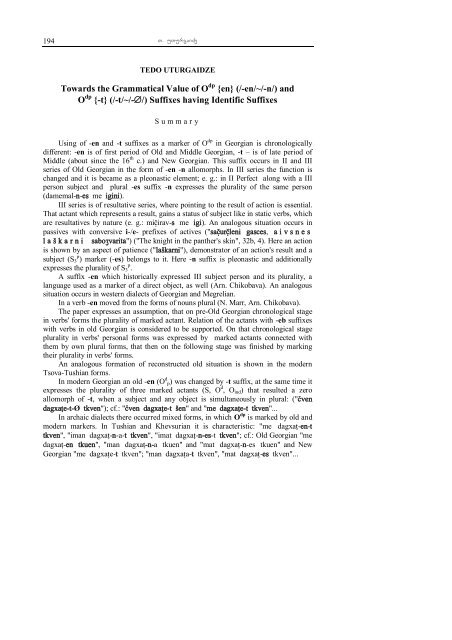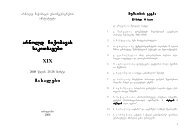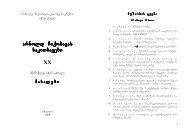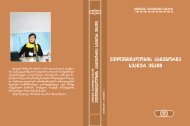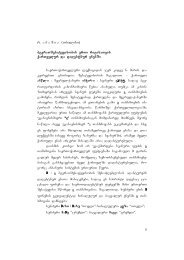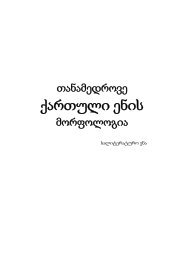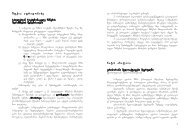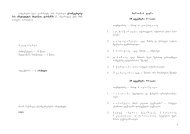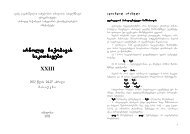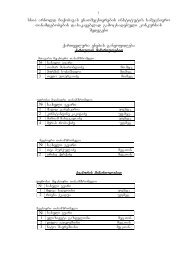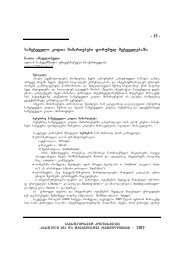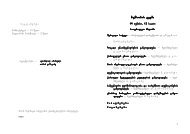iberiul-kavkasiuri enaTmecniereba XXXIX
iberiul-kavkasiuri enaTmecniereba XXXIX
iberiul-kavkasiuri enaTmecniereba XXXIX
Create successful ePaper yourself
Turn your PDF publications into a flip-book with our unique Google optimized e-Paper software.
194<br />
T. uTurgaiZe<br />
TEDO UTURGAIDZE<br />
Towards the Grammatical Value of O dp {en} (/-en/~/-n/) and<br />
O dp {-t} (/-t/~/-/) Suffixes having Identific Suffixes<br />
S u m m a r y<br />
Using of -en and -t suffixes as a marker of O dp in Georgian is chronologically<br />
different: -en is of first period of Old and Middle Georgian, -t – is of late period of<br />
Middle (about since the 16 th c.) and New Georgian. This suffix occurs in II and III<br />
series of Old Georgian in the form of -en -n allomorphs. In III series the function is<br />
changed and it is became as a pleonastic element; e. g.: in II Perfect along with a III<br />
person subject and plural -es suffix -n expresses the plurality of the same person<br />
(damemal-n-es me igini).<br />
III series is of resultative series, where pointing to the result of action is essential.<br />
That actant which represents a result, gains a status of subject like in static verbs, which<br />
are resultatives by nature (e. g.: miyirav-s me igi). An analogous situation occurs in<br />
passives with conversive i-/e- prefixes of actives ("sayuryleni gasces, a i v s n e s<br />
l a S q a r n i saboZvariTa") ("The knight in the panther's skin", 32b, 4). Here an action<br />
is shown by an aspect of patience ("laSqarni"), demonstrator of an action's result and a<br />
subject (S3 p ) marker (-es) belongs to it. Here -n suffix is pleonastic and additionally<br />
expresses the plurality of S3 p .<br />
A suffix -en which historically expressed III subject person and its plurality, a<br />
language used as a marker of a direct object, as well (Arn. Chikobava). An analogous<br />
situation occurs in western dialects of Georgian and Megrelian.<br />
In a verb -en moved from the forms of nouns plural (N. Marr, Arn. Chikobava).<br />
The paper expresses an assumption, that on pre-Old Georgian chronological stage<br />
in verbs' forms the plurality of marked actant. Relation of the actants with -eb suffixes<br />
with verbs in old Georgian is considered to be supported. On that chronological stage<br />
plurality in verbs' personal forms was expressed by marked actants connected with<br />
them by own plural forms, that then on the following stage was finished by marking<br />
their plurality in verbs' forms.<br />
An analogous formation of reconstructed old situation is shown in the modern<br />
Tsova-Tushian forms.<br />
In modern Georgian an old -en (O d p) was changed by -t suffix, at the same time it<br />
expresses the plurality of three marked actants (S, O d , Oind) that resulted a zero<br />
allomorph of -t, when a subject and any object is simultaneously in plural: ("Cven<br />
dagxate-T-Ø Tqven"); cf.: "Cven dagxate-T Sen" and "me dagxate-T Tqven"...<br />
In archaic dialects there occurred mixed forms, in which O dp is marked by old and<br />
modern markers. In Tushian and Khevsurian it is characteristic: "me dagxat-en-T<br />
Tqven", "iman dagxat-n-a-T Tqven", "imaT dagxat-n-es-T Tqven"; cf.: Old Georgian "me<br />
dagxat-en Tquen", "man dagxat-n-a Tquen" and "maT dagxat-n-es Tquen" and New<br />
Georgian "me dagxate-T Tqven"; "man dagxata-T Tqven", "maT dagxat-es Tqven"...


